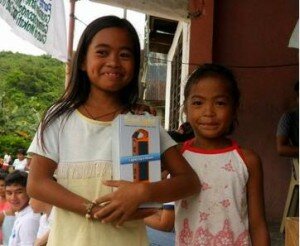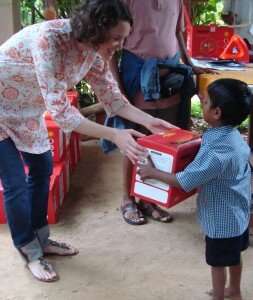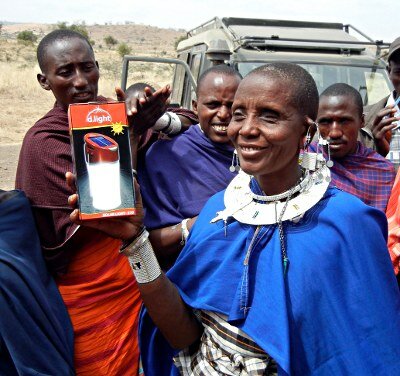Original article appeared July 16, 2013, in the online news of Duke-UNC Rotary Center
for International Studies in peace and conflict resolution.
By Samira Wellemeyer
Spreading the Light
This summer, I headed to California to assist One Million Lights as it tries to merge into public-private partnership model that will help it be a more sustainable organization, as it tries to reach its goal of distributing 1 million solar lanterns to impoverished communities around the world.
Before I left for summer I was very fortunate to apply and receive $28K grant from the Joan and Robert Gilkison Foundation toward three water projects in my district. So concurrently with my work at One Million Lights, I am currently coordinating the initiation of these projects. It is great joy to feel the anticipation by the villagers for clean water and to imagine how people’s lives will be transformed for the better.
At One Million Lights, we have been focusing on three main areas: Global Lights distributions (I have been coordinating light ambassadors around the world, especially those located in Africa and Asia), strengthening our public-private partnerships, and developing a new comprehensive Community Solar project.
We just received UN approval to distribute lights in Kakuma Refugee camp in Northern Kenya! Providing solar lanterns to individual tents and households at the campsite is a major help to these refugees who face many life’s difficulties just to make through each day.
We have also received some 1800 solar lanterns that I’m sending for distributing to impoverished schools in the Transmara Kenya.
These lights donations would not have been possible without our corporate sponsors. We have expanded to form partnerships with business corporations in order to create more predictable and sustainable sponsorships for our projects. We have good commitments from our current major corporate sponsor, Energizer and SunPower Corporation. We hope to add more corporate sponsors over the next few months.
One other exciting vision I have been tasked with is the creation of a unique comprehensive Community Solar project. We’ve dubbed it “Community Solar Asset” project. Please read the description below:
Community Solar Asset
At the core of community development is providing services that enable, stabilize and enrich the members of the community. All people and the communities we form have basic needs that underlie the ability of a community to survive and thrive. Many of these services are either made possible or better through access to electrical energy. The community solar asset uses local sustainable electrical generation (photovoltaic aka solar) to provide core services: education, food security, water security, health care and micro-enterprise A brief description of how the system provides these services, and potential applications of the platform are described later. First, I will briefly cover the capacity of the system and the communication abilities of the system, which are vital in providing the information to effectively operating and monitoring the system.
A key aspect of the system is the remote monitoring and metering of the system. It communicates over the SMS network to provide data to cloud based monitoring system that tracks and stores production and consumption data. Not only does that give a warning system for operational problems or system malfunction, it allows for rich data that tracks the utilization of the different functions of the system. By this means, we can see which services the community is accessing, track which members of the community are using these services and quantify to a specific level of detail the impact of the system on the community.
The ideology of the system to is enable best practice for usage of electrical power. Through practice we have seen applications of electrical power for uneducated public without incentive or access to capital usually pursue consumer technology and goods and create additional spending without relative increases to income and productive goods. To offset this trend the design of the proposed system to provide the infrastructure to enable productive usage of electricity, the program to incentivize its usage, the methodology to maximize its impact and the monitoring to track its application and effects.
The five core services the system provides electrical energy to improve are: education, water security, food security, health care, and micro-enterprise These essential systems form the core shared services of any communities and ensure that the community will locally generate the key aspects of its ongoing well being.
Together, these services create the framework for a robust, self-sufficient community infrastructure. When integrated with local management, community ownership and local adaptation it can be integrated as a key element providing most of the services government is expected to provide. Through leveraging monitoring we can ensure efficiency operations, minimal downtime, analyze use and also refine which uses are employed, the amount of benefit they generate for the community and the appropriate cost to any involved beneficiaries or investors.

 After a week-long distribution of 180 solar lights, Light Ambassador Sierra Fan reflects on her experience in the Philippines.
After a week-long distribution of 180 solar lights, Light Ambassador Sierra Fan reflects on her experience in the Philippines.
 The absolute joy in the face of a child who has just received his very own solar light… so that he can read at night… is 100% worth every penny.
The absolute joy in the face of a child who has just received his very own solar light… so that he can read at night… is 100% worth every penny.
 Ambassador Jessica Matthys: The solar lanterns will make a significant impact on these women‘s lives.
Ambassador Jessica Matthys: The solar lanterns will make a significant impact on these women‘s lives.